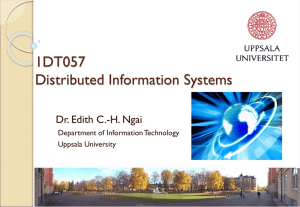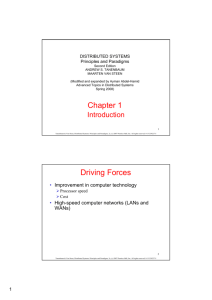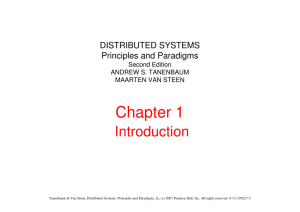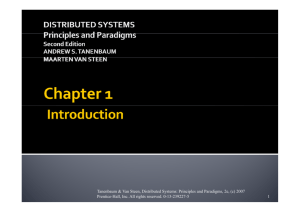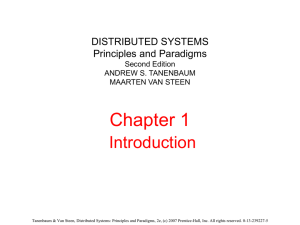Distributed Computing Systems
advertisement
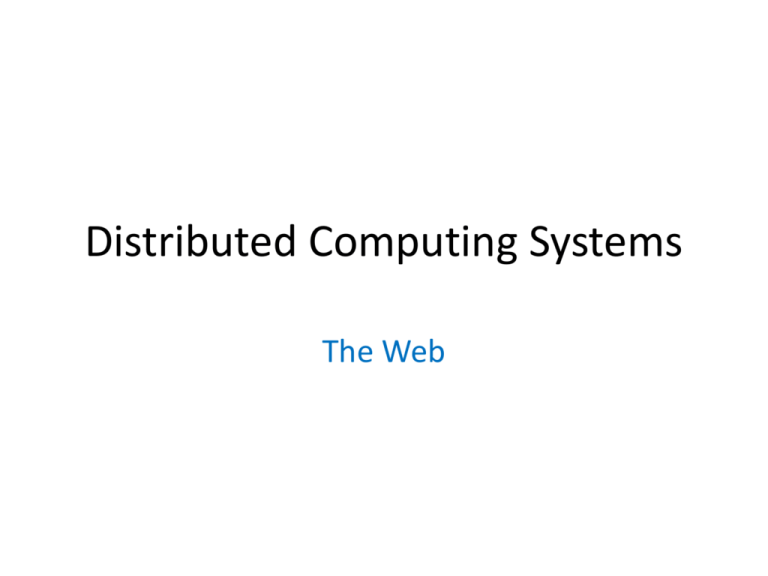
Distributed Computing Systems
The Web
The World Wide Web
• Huge client-server system
• Traditionally Document-based
– Referenced by “Uniform Resource Locator” (URL)
Andrew Tanenbaum and Marten van Steen, Distributed Systems – Principles and Paradigms, Prentice Hall, ©2002
References
• [TS02] Andrew Tanenbaum and Marten van Steen,
Distributed Systems – Principles and Paradigms,
Prentice Hall, ©2002 (ch 11)
• [KR10] James F. Kurose and Keith W. Ross, Computer
Networking - A Top-Down Approach (5th ed), Pearson,
©2010 (ch 2.2.4)
• [SAAF08] F. Schneider, S. Agarwal, T. Alpcan, and A.
Feldmann. The New Web: Characterizing AJAX Traffic,
In Proceedings of the Passive and Active Measurement
Conference (PAM), Cleveland, OH, USA, 2008
Outline
•
•
•
•
•
•
Introduction
Document Model
Architecture
Processes
Caching
Web 2.0
(done)
(next)
Document Model
• All information in documents
– Typically in Hypertext Markup Language (HTML)
– Different types: ASCII, scripts
<HTML>
<BODY>
<H1>Hello World</H1>
</BODY>
</HTML>
<!<!<!<!<!-
Start of HTML document
Start of the main body
Basic text to be displayed
End of main body
End of HTML section
-->
-->
-->
-->
-->
<HTML>
<BODY>
<SCRIPT type = "text/javascript">
document.writeln ("<H1>Hello World</H1>);
</SCRIPT>
</BODY>
</HTML>
<!- Start of HTML document -->
<!- Start of the main body
-->
<!- identify scripting language -->
// Write a line of text
<!- End of scripting section
-->
<!- End of main body
-->
<!- End of HTML section
-->
• Scripts give you “mobile code” (more later)
• Can also have eXtensible Markup Language (XML)
–
Provides structure to document
Andrew Tanenbaum and Marten van Steen, Distributed Systems – Principles and Paradigms, Prentice Hall, ©2002
XML Document Type Definition
(1)
(2)
(3)
(4)
(5)
(6)
(7)
(8)
(9)
(10)
(11)
(12)
(#PCDATA is
<!ELEMENT article (title, author+,journal)>
primitive type,
<!ELEMENT title (#PCDATA)>
series of chars)
<!ELEMENT author (name, affiliation?)>
<!ELEMENT name (#PCDATA)>
<!ELEMENT affiliation (#PCDATA)>
<!ELEMENT journal (jname, volume, number?, month? pages, year)>
<!ELEMENT jname (#PCDATA)>
<!ELEMENT volume (#PCDATA)>
<!ELEMENT number (#PCDATA)>
<!ELEMENT month (#PCDATA)>
<!ELEMENT pages (#PCDATA)>
<!ELEMENT year (#PCDATA)>
• Definition above refers to journal article. Specifies type.
– Document Type Definition (DTD)
– Provides structure to XML documents can test if XML is valid based
on DTD
Andrew Tanenbaum and Marten van Steen, Distributed Systems – Principles and Paradigms, Prentice Hall, ©2002
XML Document
(1)
(2)
(3)
(4)
(5)
(6)
(7)
(8)
(9)
(10)
(11)
(12)
(13)
(14)
(15)
Refers to previous dtd
<?xml = version "1.0">
<!DOCTYPE article SYSTEM "article.dtd">
<article>
<title>Prudent Engineering Practice for Cryptographic Protocols</title>
<author><name>M. Abadi</name></author>
<author><name>R. Needham</name></author>
<journal>
<jname>IEEE Transactions on Software Engineering</jname>
<volume>22</volume>
<number>12</number>
<month>January</month>
<pages>6 – 15</pages>
<year>1996</year>
</journal>
</article>
• (An XML document using XML definitions from previous slide)
• Formatting rules usually applied by embedding in HTML
Andrew Tanenbaum and Marten van Steen, Distributed Systems – Principles and Paradigms, Prentice Hall, ©2002
Outline
•
•
•
•
•
•
Introduction
Document Model
Architecture
Processes
Caching
Web 2.0
(done)
(done)
(next)
Architectural Overview
• Text documents typically “processed” on client
– But can be done at server, too (e.g., Common Gateway Interface (CGI))
(often with user input , e.g., a form)
Andrew Tanenbaum and Marten van Steen, Distributed Systems – Principles and Paradigms, Prentice Hall, ©2002
Server-Side Scripts
• Like Client, Server can execute JavaScript
(1)
(2)
(3)
(4)
(5)
(6)
(7)
(8)
(9)
(10)
(11)
(12)
(13)
(14)
(15)
(16)
<HTML>
<BODY>
<P>The current content of <pre>/data/file.txt</PRE>is:</P>
<P>
<SERVER type = "text/javascript");
(The tag <SERVER…>
clientFile = new File("/data/file.txt");
if(clientFile.open("r")){
is system specific)
while (!clientFile.eof())
document.writeln(clientFile.readln());
clientFile.close();
}
</SERVER>
</P>
<P>Thank you for visiting this site.</P>
</BODY>
</HTML>
• Server can also pass pre-compiled code applet
<OBJECT codetype=“application/java” classid=“java.welcome.class”>
• Servlets are applets that run on server side (Architecture next slide)
Andrew Tanenbaum and Marten van Steen, Distributed Systems – Principles and Paradigms, Prentice Hall, ©2002
Architectural Overview
Andrew Tanenbaum and Marten van Steen, Distributed Systems – Principles and Paradigms, Prentice Hall, ©2002
HTTP Connections
• Communication based on Hypertext Transfer Protocol (HTTP)
– Client request, server reply protocol
– Uses TCP
a)
Using non-persistent connections (HTTP 1.0)
• TCP connection setup expensive
b)
Using persistent connections (HTTP 1.1)
•
Can also have requests either serially or in parallel
Andrew Tanenbaum and Marten van Steen, Distributed Systems – Principles and Paradigms, Prentice Hall, ©2002
User-server State: Cookies (1 of 3)
Web servers stateless
Many major Web sites use
cookies to have state at
server
Four components:
1) cookie header line of HTTP
response message
2) cookie header line in HTTP
request message
3) cookie file kept on user’s PC,
managed by user’s browser
4) back-end database at Web
site
Example:
• Susan always access Internet from
same PC (e.g., in her home)
• Visits specific e-commerce site for
first time (e.g., amazon.com)
• When initial HTTP requests
arrives at site, site creates:
– unique ID
– entry in backend database for
ID
(see next slide for example)
James F. Kurose and Keith W. Ross, Computer Networking - A Top-Down Approach (5th ed), Pearson, ©2010
User-server State: Cookies (2 of 3)
Client
ebay 8734
cookie file
Server
usual http request msg
usual http response
set-cookie: u168
ebay 8734
amazon u168
usual http request msg
cookie: u168
(one week later)
usual http response msg
ebay 8734
amazon u1678
Amazon server
creates ID
u168 for user create
entry
cookiespecific
action
access
access
usual http request msg
cookie: u168
usual http response msg
backend
database
cookiespecific
action
James F. Kurose and Keith W. Ross, Computer Networking - A Top-Down Approach (5th ed), Pearson, ©2010
User-server State: Cookies (3 of 3)
What cookies can bring:
Cookies and privacy:
•
•
•
•
• Cookies permit some sites to
learn lots about users
authorization
shopping carts
recommendations
user session state (Web e-mail)
–
e.g., tracking visits by 3rd party
sites
• Also, persist when session
closed, so next user has
‒ e.g., public computer
• Or stolen (sniffed), or sent to
attacker if script embedded in
primary Web page
James F. Kurose and Keith W. Ross, Computer Networking - A Top-Down Approach (5th ed), Pearson, ©2010
Outline
•
•
•
•
•
•
Introduction
Document Model
Architecture
Processes
Caching
Web 2.0
(done)
(done)
(done)
(next)
Client Process: Extensible Browser
• Make client browser extensible do more than default
– A plug-in
– Associated with document type (MIME type)
Andrew Tanenbaum and Marten van Steen, Distributed Systems – Principles and Paradigms, Prentice Hall, ©2002
Client-Side Process: Web Proxy
• Initially, handle connection when browser does not “speak”
language
• Now, most browsers can handle, but proxies still used for
common cache when many browsers (e.g., NZ) or to get
“rights” of domain (e.g., proxy.wpi.edu)
• Can be useful for debugging Web session
Andrew Tanenbaum and Marten van Steen, Distributed Systems – Principles and Paradigms, Prentice Hall, ©2002
Servers
• Core invokes modules with data
– Actual module path depends upon data type
• Phases:
– authentication, response, syntax checking, user-profile, transmission
• Extend server to support different types (PHP)
Andrew Tanenbaum and Marten van Steen, Distributed Systems – Principles and Paradigms, Prentice Hall, ©2002
Server Clusters (1 of 3)
• Single server can become heavily loaded
• Front-end replicates request to back-end (horizontal
distribution)
– But can become overloaded still since all connections through
Andrew Tanenbaum and Marten van Steen, Distributed Systems – Principles and Paradigms, Prentice Hall, ©2002
Server Clusters (2 of 3)
• TCP handoff – most “work” on response, typically
– But can’t take advantage of document knowledge or caching
– Or, higher-layer has to do more work, making front-end bottleneck
Andrew Tanenbaum and Marten van Steen, Distributed Systems – Principles and Paradigms, Prentice Hall, ©2002
Server Clusters (3 of 3)
• Distributor talks to dispatcher initially, then hands off connection
• Front-end switch can stay at TCP layer, told where to send data
Andrew Tanenbaum and Marten van Steen, Distributed Systems – Principles and Paradigms, Prentice Hall, ©2002
Outline
•
•
•
•
•
•
Introduction
Document Model
Architecture
Processes
Caching
Web 2.0
(done)
(done)
(done)
(done)
(next)
Web Caching
• Browser keeps recent requests
– Proxy can be valuable if shared interests
• Check cache first, server next
• Cache is full. How to decide replacement?
– LRU (what is different than pages or disk blocks?)
– e.g., GreedyDual (value divided by size)
• How consistent should client cache be to
server content? What are tradeoffs?
Caching - Conditional GET
• Goal: don’t send object if
cache has up-to-date
cached version
• cache: specify date of
cached copy in HTTP
request:
If-modified-since:
<date>
server
cache
HTTP request msg
If-modified-since:
<date>
HTTP response
object
not
modified
HTTP/1.0
304 Not Modified
• server: response contains
no object if cached copy is
up-to-date. e.g.,
If-modified-since:
<date>
HTTP/1.0 304 Not
Modified
HTTP response
HTTP request msg
HTTP/1.0 200 OK
<data>
object
modified
Cache Coherency
• Strong consistency
– Validate each access
– Server indicates if invalid
– But requires request to server for each client request
• Weak consistency
– Validate only when client clicks “refresh”
– Or, using heuristic Time To Live (TTL)
Squid Texpire = (Tcached – Tlast_modified) + Tcached
= 0.2 (derived from practice)
• Why not have server push invalidation?
• In practice, cache hits low (50% max, only if really large)
– Make “cooperative” caches
Cooperative Web Proxy Caching
• Proxy first checks neighbors before asking server
– Shown effective for 10,000+ users
• But complicated, and often not clear win over single proxy
Andrew Tanenbaum and Marten van Steen, Distributed Systems – Principles and Paradigms, Prentice Hall, ©2002
Misc Caching
• Static vs. Dynamic documents
– Caching only effective for static docs (non CGI)
• But Web increasingly dynamic (personalized)
• Cookies used since server (mostly) stateless
– Make proxies support active caching
• Generate HTML
• Need copies of server-side scripts/code
• Accessing databases harder
• Caching large documents
– Can only send changes from original
– But in many cases, connection request is largest cost
Server Replication
• Clusters (covered)
• Deploy entire copy of Web site at another site
(mirror)
– Often done with file transfer networks (e.g., FTP
servers)
– But non-transparent (i.e., explicitly choose mirror)
• Content Delivery Network (CDN)
– Have network of cooperative caches run by
provider (next)
Akamai CDN
(“Close”
CDN Server
resolved by
DNS)
• Embedded documents have names that are resolved by Akamai DNS
to local CDN server
– Use Internet “map” to determine local server
• Local server gets copy from original server
• Akamai has many CDN servers “close” to clients
Andrew Tanenbaum and Marten van Steen, Distributed Systems – Principles and Paradigms, Prentice Hall, ©2002
Outline
•
•
•
•
•
•
Introduction
Document Model
Architecture
Processes
Caching
Web 2.0
(done)
(done)
(done)
(done)
(done)
(next)
The Web 1.0
• World Wide Web most popular application
running over HTTP
• Users click on links embedded in documents
to fetch additional documents
• Thus, in basic Web 1.0, HTTP requestresponse loads new page in response to each
user request
The Web 2.0
• Shift away from class request-response, to
asynchronous communication
• Web browsers request data without human
intervention (e.g., without clicking on link/button)
• Such requests can mask latency or limited bandwidth
– pre-fetching or
– displaying before all data has arrived
• HTTP requests are becoming automated, rather than
human generated
• AJAX is one such supporting technology
AJAX – What is it?
• AJAX – acronym for Asynchronous JavaScript
and XML
– Despite name, doesn’t have to be XML (often
JSON, a JavaScript text-based notation)
• Not stand-alone language or technology
• Methods for client-side code to create Web
applications
• Clients send and receive data asynchronously,
without interfering with display
AJAX Technologies
• AJAX uses:
– Javascript (for altering page)
– XML or JSON (for information exchange)
– ASP or JSP (server side)
• Key is the XMLHttpRequest object
• All modern browsers support XMLHttpRequest object
– Note: IE5 and IE6 uses an ActiveXObject.
• XMLHttpRequest object exchanges data with server
asynchronously
– Update parts of Web page, without reloading whole page
(illustration next)
AJAX versus Normal Web Browsing
Web 2.0 Applications
• Google Maps was early adopter of AJAX
– Encouraged others to use for interactive apps
• Many Web-email offerings use AJAX
technologies to rival desktop mail clients
The Problem
• Prediction algorithms may fetch data that is
not needed add extra data to Web
browsing
• Fetching no longer limited by user read and
click speed, but driven by JavaScript code logic
• Traditional Web traffic models (e.g., data rate
for browsing, number of objects per page)
may not hold
Web 2.0 Outline
•
•
•
•
Introduction
Approach
Results
Conclusions
(done)
(next)
Approach
• Pick four popular, “representative”,
AJAX apps and study their traffic:
– Google Maps
– Google Mail
– Gmx.de (popular German
Webmailer)
– Lokalisten.de (popular German social
network)
• Traces from networks in Munich,
Germany and Berkeley, USA
• Highlight differences in Web 2.0
traffic compared to traditional Web
1.0 traffic
Google Maps Internals
• Google Maps is AJAX
application
– Sometimes called the
“canonical” AJAX app
• Prefetches tiles
• Opens multiple TCP
connections to different
servers
• Uses cookies to identify users
• HTTP 1.1 transfers data via
persistence and pipelining
– Mostly to fetch new image tiles
– Also control, GUI-related
pictures, user queries
Analysis
• Extract standard HTTP request from all
connections
– Identified Google Maps via initial request to
maps.google.com plus session cookies Google uses
• Studied:
– Number of bytes transferred (HTTP payload)
– Number of HTTP requests
– Inter-request times
• Colors:
– Red/Pink – All HTTP
– Green – Google Maps
Web 2.0 Outline
•
•
•
•
Introduction
Approach
Results
Conclusions
(done)
(done)
(next)
Bytes Per Connection (HTTP Payload)
Bytes Per Connection (HTTP Payload)
Compare HTTP 1.0, Maps to the right, Mail to the left
(HTTP 1.0 has not changed much since 1997)
Bytes Per Session (HTTP Payload)
Requests per Session
All-HTTP:
Conclusions
• On average, versus All-HTTP, AJAX apps
– Transfer more bytes per connection and per
session
– Have more requests per session
– Have significantly shorter inter-request times
• Larger sessions and burstier traffic with AJAX
applications
• Existing Web traffic models still applicable, but
need new parameterization
